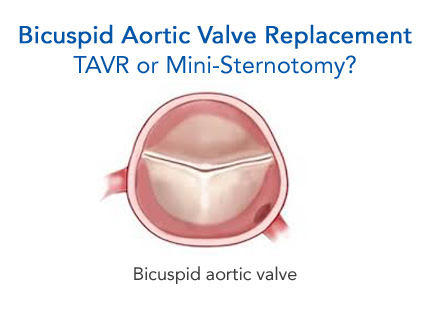“TAVR or Mini-Sternotomy for Bicuspid Aortic Valve?” asks Julie
Written By: Adam Pick, Patient Advocate, Author & Website Founder
Medical Expert: Gorav Ailawadi, MD, Chair of Cardiac Surgery, Michigan Medicine
Page Last Updated: June 6, 2025
I just received a great question from Julie about transcatheter aortic valve replacement (TAVR), mini-sternotomies and bicuspid aortic valve therapy. She writes to me, “Hi Adam, can the TAVR or mini sternotomy be used for bicuspid valve replacement?”

Julie asks a great question — as there is a good deal of confusion about the different minimally invasive approaches to treat aortic valve disease. For this reason, I contacted Dr. Gorav Ailawadi from Michigan Medicine. Dr. Ailawadi is an expert in the field of minimally invasive and transcatheter valve therapy. He’s also a really nice guy who responded to Julie’s question in under four hours.
In his response to Juile, Dr. Ailawadi made the following comments:
The TAVR procedure in the United States is approved for patients with trileaflet calcific aortic stenosis. That is, patients with 3 leaflet valves. The reason for that is patients with bicuspid valves often have more oval shapes, non-circular shape to their aortic valve and there is a concern that TAVR will results in an unpredictable leak around the valve. That said, the UVA Advanced Cardiac Valve Center and others have rarely performed TAVR in extremely high risk patients with bicuspid aortic stenosis who cannot undergo conventional surgery.
In patients who are not high risk with bicuspid aortic disease, I believe a minimally invasive approach is an excellent option. This can be done through a few different ways including a mini sternotomy. This is generally a very safe and good option and my preferred approach in ALL patients with isolated aortic valve disease who are not TAVR candidates. Finally, there are a couple new cutting edge valves that are in trial at select centers like ours investigating valves that do not require sutures or require minimal sutures. These valves are in study/ investigation currently in the United States an are approved in Europe. They can be placed relatively quickly and can minimize the time on the heart lung machine. They also make it easier to perform surgery through small incisions. — Dr. Gorav Ailawadi
I hope this helped Julie (and perhaps you) learn about the treatment of bicuspid aortic valves using minimally invasive techniques including mini-sternotomy and TAVR. Many thanks to Julie for her question and a special thanks to Gorav Ailawadi for sharing his research and clinical expertise with our patient community.
Related Links:
Keep on tickin!
Adam
|
Ralph says on February 12th, 2014 at 7:54 pm |
|
What is the likelihood in an institution such as UVA which is a teaching hospital, that the surgeon will actually perform the entire operation instead of a resident doctor? I understand the residents must learn, but not on my heart. |
 |












